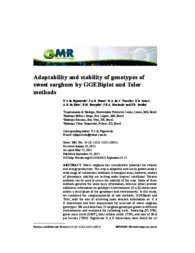Adaptability and stability of genotypes of sweet sorghum by GGEBiplot and Toler methods.
Adaptability and stability of genotypes of sweet sorghum by GGEBiplot and Toler methods.
Autoria: FIGUEIREDO, U. J. de; NUNES, J. A. R.; PARRELLA, R. A. da C.; SOUZA, E. D.; SILVA, A. R. da; EMYGDIO, B. M.; MACHADO, J. R. A.; TARDIN, F. D.
Resumo: Sweet sorghum has considerable potential for ethanol and energy production. The crop is adaptable and can be grown under a wide range of cultivation conditions in marginal areas; however, studies of phenotypic stability are lacking under tropical conditions. Various methods can be used to assess the stability of the crop. Some of these methods generate the same basic information, whereas others provide additional information on genotype x environment (G x E) interactions and/or a description of the genotypes and environments. In this study, we evaluated the complementarity of two methods, GGEBiplot and Toler, with the aim of achieving more detailed information on G x E interactions and their implications for selection of sweet sorghum genotypes. We used data from 25 sorghum genotypes grown in different environments and evaluated the following traits: flowering (FLOW), green mass yield (GMY), total soluble solids (TSS), and tons of Brix per hectare (TBH). Significant G x E interactions were found for all traits. The most stable genotypes identified with the GGEBiplot method were CMSXS643 for FLOW, CMSXS644 and CMSXS647 for GMY, CMSXS646 and CMSXS637 for TSS, and BRS511 and CMSXSS647 for TBH. Especially for TBH, the genotype BRS511 was classified as doubly desirable by the Toler method; however, unlike the result of the GGEBiplot method, the genotype CMSXS647 was also found to be doubly undesirable. The two analytical methods were complementary and enabled a more reliable identification of adapted and stable genotypes.
Ano de publicação: 2015
Tipo de publicação: Artigo de periódico
Unidade: Embrapa Milho e Sorgo
Palavras-chave: Bioenergia, Etanol, Sorghum bicolor
Observações
1 - Por padrão são exibidas publicações dos últimos 20 anos. Para encontrar publicações mais antigas, configure o filtro ano de publicação, colocando o ano a partir do qual você deseja encontrar publicações. O filtro está na coluna da esquerda na busca acima.
2 - Para ler algumas publicações da Embrapa (apenas as que estão em formato ePub), é necessário ter, no celular ou computador, um desses softwares gratuitos. Sistemas Android: Google Play Livros; IOS: iBooks; Windows e Linux: software Calibre.
Acesse outras publicações
Acesse a Base de Dados da Pesquisa Agropecuária (BDPA) para consultar o acervo completo das bibliotecas da Embrapa.

